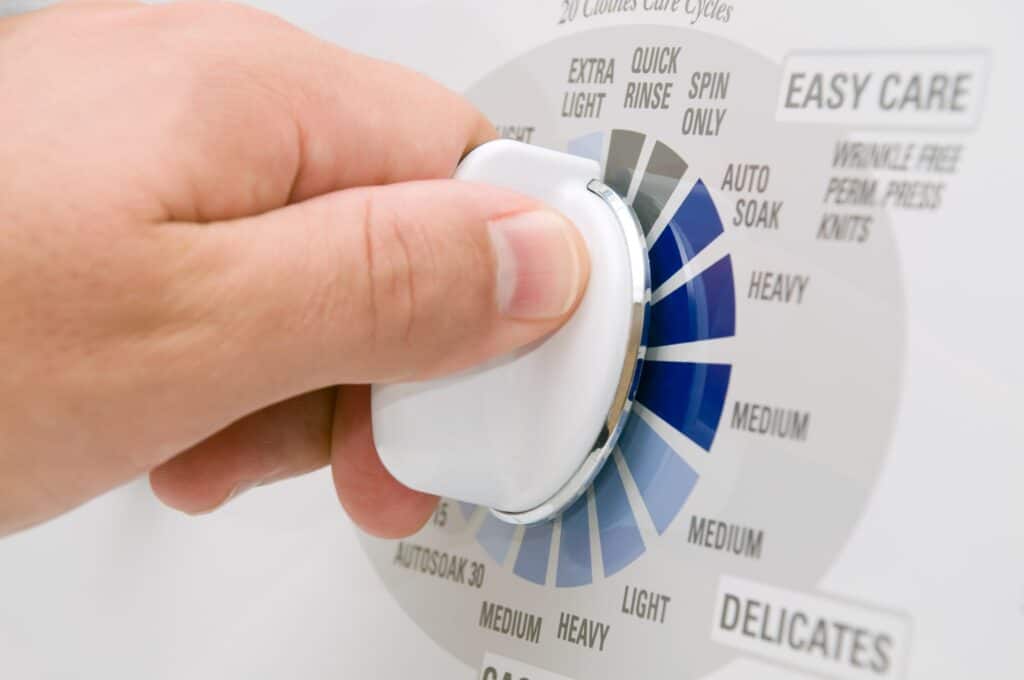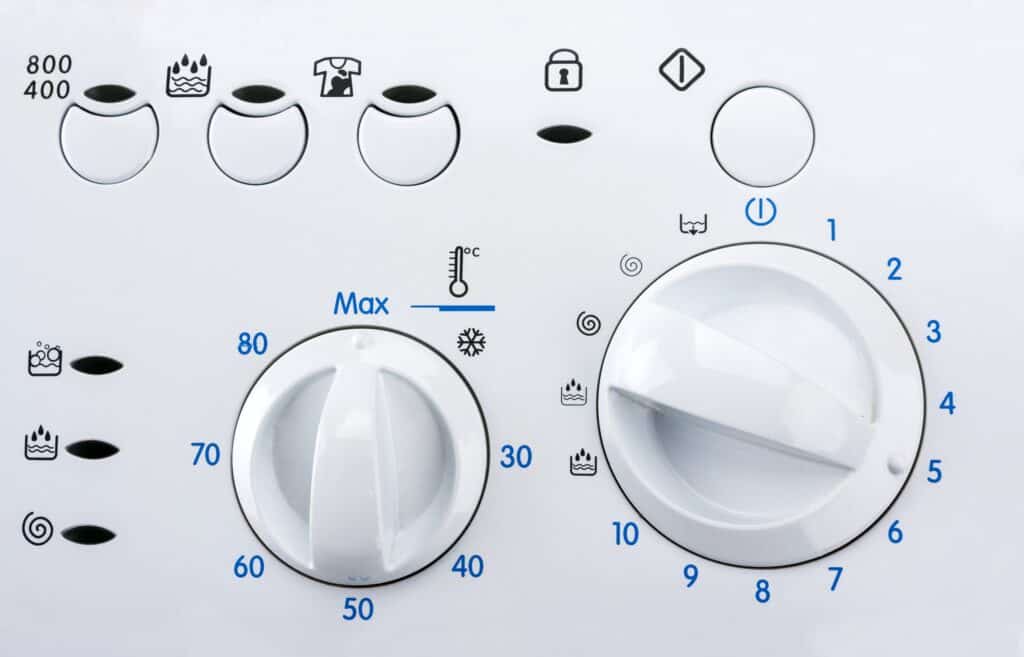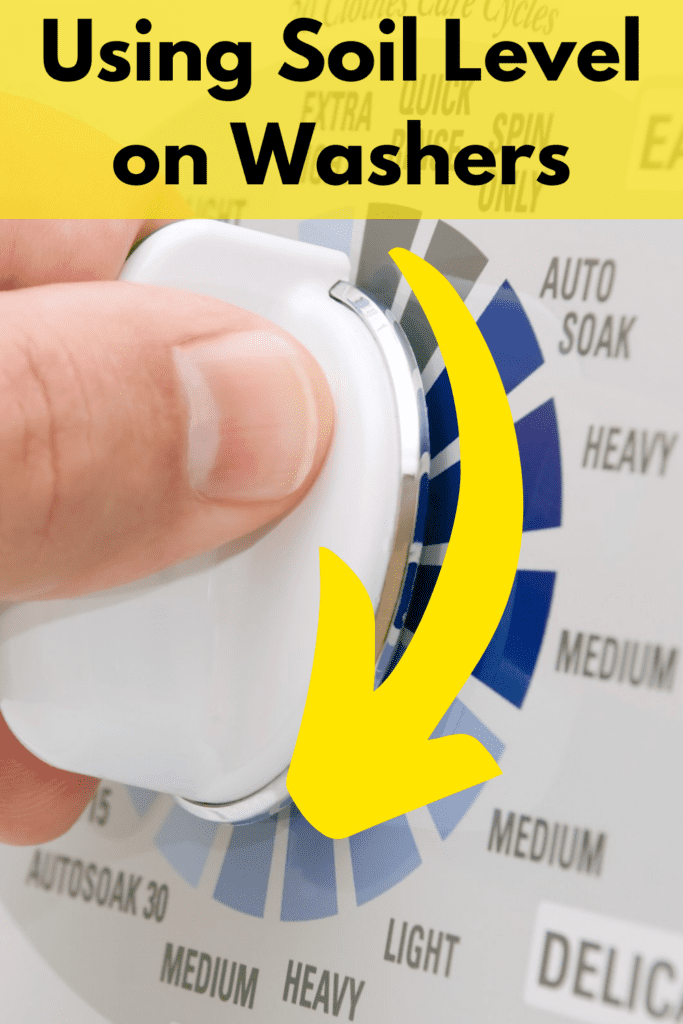When you assemble the laundry from around the house, you’ll notice that not all the clothes have the same soil level. The kids’ socks will be very soiled, but the blouse you wore to the office only the day before is only slightly, if at all, soiled.
The washer has different soil level settings to help you get your laundry cleaned while conserving energy and water consumption. The three common soil level settings are Light, Normal, and Heavy. Each soil level has different water, energy, temperature, and duration settings.
Soil level settings are designed to help you determine the best setting for your laundry based on the soil level of the clothes. It’s an added feature that finetunes the wash process and allows you to customize it even further. Read more to find out what soil level settings are and how to make the most out of them.
What is the Soil Level Setting?
The soil level setting in the washer is an important feature that customizes the wash cycle based on the degree of soil of the laundry. Heavily soiled clothes need more water agitation and extra time.
This extra long cycle translates into more water consumption, more energy usage, and more exposure to the laundry detergent. But not all clothes need this. Only those with heavy soil levels should get this extra treatment.
But it’s not just the soil level that determines which soil setting you should use. The fabric type also plays a major role, as we’ll see later. For example, heavily soiled lace or nylon garments should never be used with the heavy soil setting in the washer.
The reason is simple. These thin fabrics repel soil and dirt, and no matter how soiled they are, they’ll always wash clean in a short time and with little water agitation inside the washer. A heavy-soil setting would be overkill and could damage the fabrics.
The bottom line is that while the soil levels of the laundry are extremely important in adjusting the wash cycle, they’re by no means the only determining factor. You can think of them as more of a guideline rather than a code set in stone.
The Different Soil Levels

Most washers have only three soil-level settings. These correspond to lightly soiled, medium soiled, and heavily soiled clothes. Understandably it might not be easy to squeeze your laundry into these three rigid classifications.
Some clothes might fall between the light and medium levels. Others might be a little more soiled than normal but by no means heavily soiled. So what should you do with these clothes?
Let me simplify things for you a little bit.
Light Soil
This is the default setting for your washer. It treats all clothes as lightly soiled with hardly any stains on them and certainly no tough stains that require extra cleaning. It’s also the quickest setting of all three.
If you don’t touch the Soil dial and change the setting, the washer will follow its original built-in program without any changes. For the most part, this is exactly what you need.
The light soil setting is suitable for dusty clothes, work clothes that hardly get any dirt, excessive sweating, or any type of stain on them.
It’s also the recommended setting for delicate, sensitive, and thin fabrics. Use it with lace, nylons, and flimsy undergarments.
Normal Soil

This setting uses more water agitation, faster spin, and a little longer time than the light soil setting. Water temperature would be slightly higher as well to work on the stains.
The normal soil setting is for fresh stains that don’t require pre-wash treatment. You can use it with home clothes and activewear as long as you wash them after every use.
Fabrics like synthetics and hybrids would benefit from the normal soil setting.
Heavy Soil
This is the highest setting for many washers. It adds more minutes to the wash cycle, uses the highest temperature setting, spins faster, and adds more agitation for more efficient cleaning.
Of course, all of this extra work comes at a cost. The washer uses more water and energy under this setting than the other two settings combined. So you should only reserve it for the extra soiled clothes.
Use it with heavy clothes such as denim, towels, bed sheets, and tablecloths.
Benefits of Soil Level Settings
I mentioned that the main advantage of those different soil levels is to give you more control over how the wash cycle should be. Its duration, level of agitation, spin speed, and water levels.
But there are other benefits too to the soil button on the washer.
- It groups different settings under one setting.
- It saves you the time of fiddling with different dials related to water level and water temperature, among others.
- The soil level setting finetunes the wash process and gets the laundry clean more efficiently.
- It helps you conserve water and energy by selecting the right setting for the laundry.
- You can use it in combination with other settings on the washer to improve the quality of the washing.
The Relationship between Soil Level and Water Level
If you read the article from the beginning, you might have noticed that the water level increases with some soil level settings. But that doesn’t always have to be the case.
The relationship between the soil level and water level in the washer is complicated at best.
That’s because the soil level doesn’t just refer to how soiled the laundry is. But it also points out the amount of debris, lint, and grime in the washer itself, specifically in the drum.
So if we’re talking about the soil level of the laundry, then the more soiled the clothes, the more water is needed to clean them thoroughly. In that case, the highest soil level will use more water than the one under it and so on.
As for the washer soil level itself, that has nothing to do with the wash cycle. Most modern washers have a self-clean feature that removes debris, dirt, and grime. If your washer doesn’t have this feature, add a heavy-duty laundry, set the washer to a heavy-duty cycle, and let it run empty.
As for the lint, you will need to collect that manually from the filters.
The Soil Button on the Washer
And now we come to the soil button itself. That’s where the magic happens. This single button gives you control over many settings and features in the washer. So what is the soil button exactly?
Put simply, the soil button is a one-stop solution that saves you the time of setting the water level, spin speed, agitation, water temperature, and duration of the wash cycle. That’s right. You can set all of that with the soil button.
Each washer has preset programs with predefined settings in each program. When you choose a program, you implicitly accept all the settings that come with it.
But sometimes, you would want to customize those settings. Many washers will let you create your own program. But what if you don’t have the time to do that and you don’t like any of the preset programs?
Then the soil button is the right option for you.
You have three settings: Light, Normal, and Heavy. Each one will adjust all of those settings automatically, depending on your selection.
How to Adjust the Soil Level on the Washer
So now we know what the soil button is, how do we adjust the soil level to communicate with the washer the level of cleanliness you desire?
It’s as simple as moving the button or pressing it repeatedly, depending on the brand and model of the washer. Some buttons are like a dial that you move to the left or right to adjust between the three soil levels.
If the washer has a panel, then you can press the soil button to select the soil level you want. It’s that simple.
Keep in mind that if you customize the water level, temperature, or any other setting of the cycle, this will override the soil level you have chosen. The washer accepts the last input from you and erases any previous adjustments you have made.
Soil Levels and Fabric Types
As I have mentioned before, the soil level of the laundry is not the only decisive factor that guides you as you select the right setting on the soil button.
The fabric type is a more important factor.
Let me give you an example.
Let’s say you have a lacy camisole top that went through a long interstate road trip or a yoga session, or a strenuous gym session. Which setting would you choose for this item of clothing?
It’s soaked with sweat, that’s true. But it still goes under the light soil setting. The thin lacy fabric will shed the sweat, dust, and other dirt rather quickly without the need for a long wash cycle with excessive agitation.
Compare that with a slightly soiled denim skirt that you only wore once but kept it hanging for a while and never got to wear again since. This one should go under the heavy soil setting.
It’s all about the fabric. The heavy denim skirt needs more time to get clean compared to the heavy soiled lacy garment.
FAQs
How can I Determine the Soil Level of my Laundry?
The first clue is stains. You don’t have to give the clothes the smell test to determine their soil level. At least not now.
Look for stains or any discoloration in the clothes. If you find many stains, the clothes should get the heavy soil setting. Few fresh stains means it’s just normal soil and no stains mean light soil.
If you can’t find any stains, smell the laundry. If there’s a funky smell, then the heavy soil setting is needed to get the odors out.
If the laundry has neither visible stains nor odors, then it just needs a quick wash cycle on a light soil setting.
What’s the Most Common Soil Level Setting for doing Laundry?
Normal soil is the most common soil level setting you’ll use. This soil setting has the same settings as the Normal or Regular cycle on your washer.
This soil setting is suitable for everyday clothes, home clothes, office outfits, and clothes with a few numbers of fresh stains that don’t require pre-treatment.
If the stains are grease or oil-based, then you will need the heavy soil setting. Also, use this setting with natural fabrics such as cotton and linen along with hybrids.
How do you Choose the Right Soil Level for your Fabric Type?
To make sure that the washer has the right settings for the type of laundry you’re doing, check the type of the fabric and the level of soil in that order.
Delicate fabrics such as nylon, silk, lace, satin, cashmere, and synthetics all go automatically under the light soil setting. It doesn’t matter how soiled or dirty they are. These sensitive fabrics will damage easily if they’re subjected to heavy agitation, high water temperature, or fast spins.
Everyday clothes made of cotton, linen, and hybrids will need the normal soil setting. This also includes office clothes and casual wear that you only use once or twice before tossing it into the washer.
Heavy fabrics such as denim, jackets, sweaters, towels, beddings, and tablecloths need more time in the washer. You don’t wash these items every day, so you should use the heavy soil setting.

Conclusion
The soil level of the laundry is not the only factor that you have to pay attention to when adjusting the settings of the washer. A more important factor is the type of fabric you’re washing.
Most washers have three soil-level settings. Use the light soil setting for delicate fabrics and slightly soiled clothes.
The normal soil setting is for everyday clothes and office clothes that you only wear once or twice.
The heavy soil setting is for jeans, towels, and beddings.
I’ve created a comprehensive guide on how to use all the settings on your washing machine that may interest you to read next.

I’m an expert wardrobe organizer and a bit of a clean freak. I created this website and its YouTube channel to share practical guides about laundry and organizing. My teachings have been featured in multiple large news publications, and I’ve self-published two wardrobe organizing books and an entire course on the subject.
